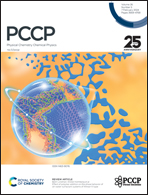TiB4 and SrB8 monolayers: high capacity and zero strain-like anode materials for Li/Na/K/Ca ion batteries†
Abstract
Storage capacity, average open circuit voltage (OCV), diffusion barrier, lattice parameter changes, etc. are key indicators of whether a material would be suitable for use as a Li-ion or non-Li-ion battery (LIB or NLIB) anode. The rapid development of 2D materials over the past few decades has opened up new possibilities for these metrics. Using first-principles calculations, we prove that two 2D materials, TiB4 and SrB8, show excellent performance in terms of the above metrics when used as anodes for LIBs or NLIBs. As detailed, TiB4 has an Li\Na\K\Ca storage capacity of 588 mA h g−1, 588 mA h g−1, 588 mA h g−1, and 1176 mA h g−1, respectively, and SrB8 has an Li\Na\K\Ca storage capacity of 308 mA h g−1, 308 mA h g−1, 462 mA h g−1, and 616 mA h g−1, respectively, and they show good electrical conductivity whether existing Li, Na, K or Ca is adsorbed or not. The diffusion barriers on both surfaces are low, indicating good rate performance. The average OCV is also very low. In particular, the lattice parameters of the two materials change very little during the embedding of Li\Na\K\Ca. For Ti9B36 the corresponding values are about 0.37% (Li), 0.33% (Na), 0.64% (K) and 0.03% (Ca), and for Sr8B64 the corresponding values are about 0.70% (Li), 0.16% (Na), 0.13% (K) and 0.004% (Ca), which imply zero strain-like character and great cycling performance. All the above results show that TiB4 and SrB8 monolayers are very promising Li\Na\K\Ca ion battery anodes.



 Please wait while we load your content...
Please wait while we load your content...